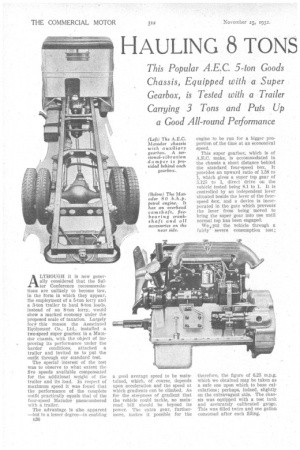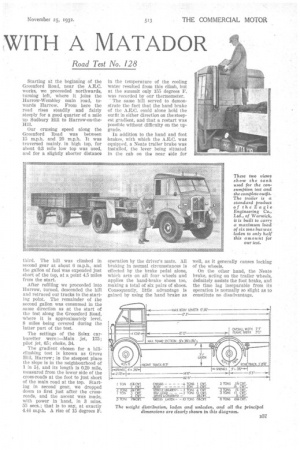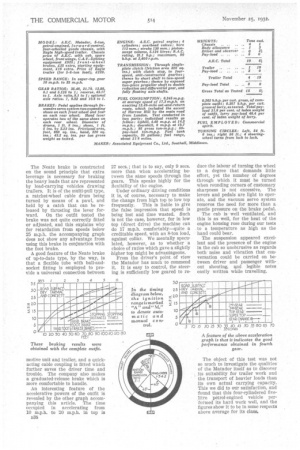HAULING 8 TONS WITH A MATADOR This Popular AEC. 5-ton
Page 54

Page 55

Page 56

If you've noticed an error in this article please click here to report it so we can fix it.
Goods Chassis, Equipped with a Super Gearbox, is Tested with a Trailer Carrying 3 Tons and Puts Up
a Good All-round Performance
Road Test No. 128
ALTHOUGH it is now generally considered that the Salter Conference recommendations are unlikely to become law, in the form in which they appear, the employment of a 5-ton lorry and a 3-ton trailer to haul 8-ton loads, instead of an 8-ton lorry, would show a marked economy under the proposed scale of taxation. Largely for?, this reason the Associated Equipment Co., Ltd., installed a two-speed super gearbox in a Matador chassis, with the object of improving its performance under the harder conditions, attached a trailer and •invited us to put the outfit through our standard test.
The special interest of the test was to observe to what extent the five speeds available compensated for the additional weight of the trailer and its load. In respect of maximum speed it was found that the performance of the complete outfit practically equals that of the four-speed Matador unencumbered with a trailer.
The advantage is also apparent —but to a lesser degree—in enabling B36 a good average speed to be maintained, which, of course, depends upon acceleration and the speed at which gradients can be climbed. As for the steepness of gradient that the vehicle could tackle, no mainroad bill should be beyond its power. The extra gear, furthermore, makes it possible for the engine to be run for a bigger proportion of.the time at an economical speed.
This super gearbox, which is of A.E.C. make, is accommodated in the chassis a short distance behind the standard four-speed box. It provides an upward ratio of 1.58 to 1, which gives a super top gear of 5.125 to 1, direct drive on the vehicle tested being 8.1 to 1. it is controlled by an independent lever situated beside the lever of the fourspeed ibox, and a device is incorporated in the gate which prevents the lever from being moved to bring the super gear into use until normal top has been engaged.
We.„4:put the vehicle through a fairly severe consumption test; therefore, the figure of 6.25 m.p.g. which we obtained may be taken as a safe one upon which to base calculations; perhaps, indeed, slightly on the extravagant side. The chassis was equipped with a test tank and accurately calibrated. gauge. This was tilled twice and one gallon consumed after each filling.
Starting at the beginning of the Greenford Road, near the A.E.C. works, we proceeded northwards, turning left, where it joins the Harrow-Wembley main road, towards Harrow. From here the road rises steadily and fairly steeply for a good quarter of a mile up Sudbury Hill to Harrow-on-theHill.
Our cruising speed along the Greenford Road was between 15 m.p.h. and 20 m.p.h. It was traversed mainly, in high top, for about 0.3 mile low top was used, and for a slightly shorter distance third. The hill was climbed in second gear at about 6 m.p.h., and the gallon of fuel was expended just short of the top, at a point 4.5 miles from the start.
After refilling we proceeded into Harrow, turned, descended the hill and retraced our tracks to the starting point. The remainder of the second gallon was consumed in the same direction as at the Start of the test along the Greenford Road, where it is approximately level, 8 Miles being covered during the latter part of the test.
The settings of the Solex carburetter were:—Main jet, 175; pilot jet, 65; choke, 34.
The gradient chosen for a hillclimbing test is known as Grove Hill, Harrow; in the steepest place the slope is in the neighbourhood of 1 in 51, and its length is 0.29 mile, measured from the lower side of the cross-roads at the foot to just short of the main road at the top. Starting in second gear, we dropped down to first just after the crossroads, and the ascent was made, with power in hand, in 3 mins. 55 secs.; that is to say, at exactly 4.44 m.p.h. A rise of 15 degrees F. in the temperature of the cooling water resulted from this climb, but at the summit only 155 degrees F. was recorded by our thermometer.
• The same hill served to demonstrate the fact that the hand brake of the A.E.C. could alone hold the outfit in either direction on the steepest gradient, and that a restart was posAble without difficulty on the upgrade.
In addition to the band and foot brakes, with which the A.E.C. was equipped, a Neate trailer brake was installed, the lever being situated in the cab on the near side for operation by the driver's mate. All braking in normal circumstances is effected by the brake pedal alone, which acts on all four wheels and applies the hand-brake shoes too, making a total of six pairs of shoes. Consequently, little advantage is gained by using the hand brake as well, as it generally causes locking of the wheels.
On the other hand, the Neate brake, acting on the trailer wheels, definitely assists the foot brake, and the time lag inseparable from its operation is normally so slight as to constitute no disadvantage. The Neate brake is constructed on the sound principle that extra leverage is necessary for braking the heavy loads that are represented by load-carrying vehicles drawing trailers. It is of the Multi-pull type, a ratchet-wheel cable drum being turned by means of a pawl, and held by a catch that can be released by thrusting the lever for ward. On the outfit tested the brake was not quite correctly fitted or adjusted, and this explains why for retardation from speeds below 25 m.p.h. the accompanying graph does not show any advantage from using this brake in conjunction with the foot brake.
A good feature of the Neate brake of up-to-date type, by the way, is that a flexible tube with ball-andsocket fitting is employed to provide a universal connection between motive unit and trailer, and a quickacting cable coupling is fitted which further saves the driver time and trouble. The company also makes a graduated-release brake which is more comfortable to handle.
An interesting feature of the accelerative powers of the outfit is revealed by the other graph accompanying this article. The time occupied in accelerating from 10 m.p.h. to '20 m.p.h, in top is
27 secs.; that is to say, only 9 secs. more than when accelerating between the same speeds through the gears. This speaks highly for the flexibility of the engine.
Under ordinary driving conditions it is, of course, necessary to make the change from high top to low top
frequently. This is liable to give the false impression that speed is being lost and time wasted. Such is not the case, however, for in low top (direct drive) the machine can do 17 m.p.h. comfortably—quite a creditable speed, with an 8-ton load, against collar. We mentally speculated, however, as to whether a choice of ratios which gave a slightly higher top might be advantageous.
From the driver's point, of view the Matador has much to commend it. It is easy to control, the steering is sufficiently low geared to re
duce the labour of turning the wheel to a degree that demands little effort, yet the number of degrees through which it must be turned when rounding corners of customary sharpness is not excessive. The levers and pedals are light to operate, and the vacuum servo system removes the need for more than a gentle pressure on the brake pedal.
The cab is well ventilated, and this is as well, for the heat of the engine housing rose during our tests to a temperature as high as the hand could bear.
The suspension appeared excellent and the presence of the engine in the cab so unobtrusive as regards bothnoise and vibration that conversation could be carried on between driver and passenger without shouting, and legible notes easily written while travelling.
The object of this test was not so much to investigate the qualities' of the Matador itself as to discover its suitability for trailer work and the transport of heavier loads than its own actual carrying capacity. This we did to our satisfaction, and found that this four-cylindered five
litre vehicle performed its hard work well, and the figures show it to be in some respects above average for its class.




































































































